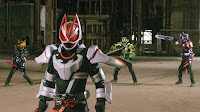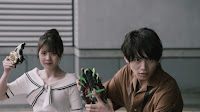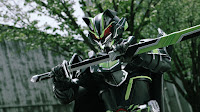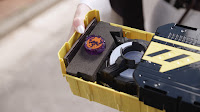The Desire Grand Prix - a survival game competition where entrants must protect the city from a mysterious threat known as the Jyamato. Each issued with unique ID core and a Desire Driver, players become Kamen Riders to work through a number of challenges to be crowned the victor and claim the ultimate prize - the ability to rewrite the world with any wish that they desire. The undefeated champion of the DGP is Ace Ukiyo, who fights as the titular Kamen Rider Geats.
Keiwa Sakurai, a caring but naive optimist who wishes for world peace. Michinaga Azuma, a man who wishes for the power to destroy all Riders after seeing his friend killed as part of the DGP. Neon Kurama, a social media influencer who wishes to break free of her wealthy family and find true love. These are just some of the Riders that enter the Desire Grand Prix alongside Ace, working both together and against one another to win their desired reality. But as the games progress, the mysterious behind the Jyamato and DGP are slowly unravelled - revealing a struggle that's been fought across time itself.
48 episodes may be around the standard length for a Kamen Rider series but it's impressive just how much Kamen Rider Geats manages to pack into this time. What starts as a show about a group of Kamen Riders taking part in a series of fairly innocuous (albeit dangerous) challenges turns into a much wider story involving time-travel, reincarnation, god-like powers and of course the whole planet at stake. This narrative is broken down into a total of seven distinct story arcs, with each one referring to a different "season" of the Desire Grand Prix. By juggling this many elements it often at times comes close to being crushed under its own weight, but manages to avoid it through a superb level of world-building. While time is taken to explain everything, the show doesn't tend to dwell on the small details and lets it flow with the story rather than swathes of exposition. The escalation of both the stakes and storyline feel calculated rather than it just suddenly jumping to an extreme when it makes its move toward an endgame. Even little touches like the inclusion of onscreen text at the end of each episode to remind the viewer of a DGP (or whatever form it has taken during that arc) rule go a long way to keep the parameters of the show in check. While it wouldn't be fair to say that everything is handled perfectly (they rarely are no matter how good a show may be), how Geats is able to tie all these elements - many of which would be a lot to take in on their own, together without reality losing sight of any of them is impressive.
Leading the show is Ace Ukiyo, our titular Rider and long-reigning champion of the Desire Grand Prix. Following in the footsteps of Tendou Souji and to a lesser extent Tsukasa Kadoya, Ace is the confident kind of Kamen Rider protagonist – skilled, but cocky nearly to the point of arrogance. It's an archetype which doesn't always work for the main protagonist, but in multi-Rider shows like Geats how he effects on the rest of the cast's development is almost as important as his own. There's a lot of fun to be had in Ace's confidence, with Hideyoshi Kan doing a great job of selling a character who always seems one step ahead of everyone else. This is the Geats we see in the show's early episodes, but as the story progresses into further arcs Ace becomes a little more complex. The charisma is still there, but much like how he fares against the Riders themselves his battle against the DGP itself is being fought on a higher level. His backstory is another example of the show possibly overcomplicating things at times, but thankfully it doesn't get too bogged down with trying to explain it all. The move into the battle against the DGP itself and the mysteries surrounding the Desire Goddess signal a subtle but noticeable shift for Ace, where his qualities as the "hero" of the piece start to stand out more. We see both his personal motivations, and then the actions he takes following on from that struggle to turn the world into a better place for everyone. Being an engaging protagonist alone and one that's there to enhance the supporting cast is a difficult balancing act to pull off, but as the series teaches us – if there's anyone who could walk that fine line it's Ace Ukiyo.
Four players aren't enough to make up a Desire Grand Prix though, so Geats fleshes its setting out with a dozen or so other Riders that play far more minimal roles in the story. Some of them are simply there as cannon fodder to highlight the dangers of the DGP, while others might play more prominent roles in certain story arcs to present a certain type of player or dynamic within the games. For example, Morio (Kamen Rider Mary) and Kanato (Kamen Rider Da-paan) are among the more unsavoury candidates selected for the DGP, while others like Sae (Kamen Rider Lopo) and Win (Kamen Rider PunkJack) are more fleshed out – showing similar tactics are first but developing into more nuanced characters as their backstories are established or we see them interact with the principle cast. Some, such as Win or Daichi (Kamen Rider Nadge-Sparrow) even go beyond the confines of being Riders – remaining part of the storyline long after their stints in the DGP have ended. While it's likely that not everyone will be satisfied by how well these characters are used and argue that some deserved more screen time than others (not giving Neon's bodyguards John and Ben Rider forms will remain one of the show's biggest crimes), overall the series has a good sense of how to use its cast even if it is only sparingly or to get a certain point across. Most characters have the opportunity to make their mark on the show in some way, and for those that don't there's always the possibility that might show up in some sort of V-cinema or web spin-off one today. When it comes to big multi-Rider shows like this that's exactly the kind of thing the Toei Tokusatsu Fan Club specials should be used for.
The introduction of the future Riders, as well as several other characters involved in the DGP who have travelled back in time, also add an additional layer of character on top of the players themselves. As his previous works have shown, Takahashi is not averse to a bit of social commentary in his writing and this time its fandom itself in his firing line. Each of four main "future Riders" introduced represent a different element of fanaticism that is critiqued upon through their interactions with their respective Rider. Ziin has been following Ace for years and even helping pull strings in his favour, yet Ace has absolutely no idea who he is – highlighting the kind of parasocial relationships certain fans can have. Kyuun is initially intrigued by Neon's desire to find love and happiness, but eventually finds himself to have feelings towards her. However Beroba and Kekera, the supporters of Michinaga and Keiwa respectively, feel far more targeted toward Kamen Rider fans themselves – suggesting perhaps why they play a much bigger part in the latter half of the story. Beroba finds pleasure in watching Micchy fall deeper in despair, twisting the idea of fans who find themselves favouring characters who repeatedly face adversity. It asks the question of how these fans might be should they have the ability to dictate their favourites story, perverting it to the utmost extreme. But Kekera's investment in Keiwa might just be the most scathing of all, as he attempts to mould him into what he considers to be a "true" Kamen Rider. His belief that one must go through some sort of deep tragedy to attain that status feels eerily similar to the divide between the Showa and Heisei era Riders – something that was even called out in the Heisei Rider vs Showa Rider: Kamen Rider Taisen feat. Super Sentai film. This paints Kekera as the kind of toxic old school fan that's stuck in the past, refusing to acknowledge the evolution the franchise has had over the last 50 years. While their (largely CGI) Rider forms might not be all that interesting, the way these characters insert themselves into the story is – keeping the relationships and interactions between Geats' oversized cast interesting even when the idea of time travel runs the risk of overcomplicating things.
"Villains" take many different forms within the show, but there is none more evil than the Desire Grand Prix itself - or more specifically the administrators behind it. Over the course of Kamen Rider Geats the DGP is run by a number of different Game Masters, with the Producers also getting involved as the tide begins to turn against them. Much like the players some leave more impact on the show than others, but they all bring their own sense of leadership to the DGP and help create the sense of it being this grand reality show that's transcended time itself. The interplay of them of them working both together and against one another to further their stature also further enhances Geats' complex web of character dynamics. And this is all without discussing the Jyamato themselves, who as the main monsters of the series still play a key role even it when it diverges into stricter Rider versus Rider scenarios. The evolution of these seemingly mindless creatures is another of Geats' greatest mysteries in its front half, opening things up to the wider workings of the DGP as well as a different trajectory for certain characters. It all makes it sounds like Kamen Rider Geats has a lot of elements that can be hard to keep track of, but the world-building is done in such a way that its parts are intertwined close enough that they all stay reasonably in the foreground.
With both story and characters accounted for, there's still one more aspect that Kamen Rider Geats managed to excel at – the visuals. Straight off the bat one would expect a multi-Rider show to be quite the spectacle, but what particularly makes Geats stand out is the ways it expands upon the parameters of the Desire Grand Prix through its look and style. There simply isn't the budget to give each and every Rider that appears their own fully unique suit, but the show gets around this by bringing Rider into the DGP on a level playing field. Though they all share the same blank Entry Form, their unique ID cores and animal-themed helmets mean they each retain a strong sense of identity – even with the remoulding of certain helmets into others apparent as the series goes on. The power-ups the Riders gain through the course of the DGP are varied – from standard weaponry (some of which cleverly recycled from previous shows) to properly-themed form changes. While each of the core Riders gets a Raise Buckle that could be considered their default "form" as such, the degree of interchangeability they offer keeps things interesting – particularly in the earlier episodes before forms become more set in stone. While neither the concepts of blank Rider forms or interchangeable armour may be unique to Geats, it's how well these things are done that make them so exciting.
The inspiration taken from survival-style video games is also apparent in how anything is on the table when it comes to these forms. This is a series where the likes of gun, ninja, zombie and music-based forms can all co-exist side by side, but what sets it apart from something like Ex-Aid (where they were supposed to represent different genres of gaming) is that these all feel like they come from the same thing despite being so wildly different. This variety makes for some really impressive fight scenes, both in relation to the choreography itself and the special effects overlaid on top. The show's "revolve" gimmick, in which armour can be used by either the upper or lower half of the body, is another interesting aspect that only furthers this. As tends to be the case with Rider gimmicks it becomes a little more side-lined as more advanced forms come along, but those have plenty to offer as well. Much like the character development the distribution of more powerful forms is reasonably well-spread amongst the principle cast even if of course Geats himself always comes out on top. The introduction of these forms always signals one of the show's most memorable fight scenes, particularly with Geats as his reality-bending powers become more ingrained. The Geats IX features what is perhaps one of the coolest moments of fourth-wall breaking to ever be placed in a Kamen Rider show, and deserves to one down as one of the all-time best final form debuts for that alone.
The inspiration taken from survival-style video games is also apparent in how anything is on the table when it comes to these forms. This is a series where the likes of gun, ninja, zombie and music-based forms can all co-exist side by side, but what sets it apart from something like Ex-Aid (where they were supposed to represent different genres of gaming) is that these all feel like they come from the same thing despite being so wildly different. This variety makes for some really impressive fight scenes, both in relation to the choreography itself and the special effects overlaid on top. The show's "revolve" gimmick, in which armour can be used by either the upper or lower half of the body, is another interesting aspect that only furthers this. As tends to be the case with Rider gimmicks it becomes a little more side-lined as more advanced forms come along, but those have plenty to offer as well. Much like the character development the distribution of more powerful forms is reasonably well-spread amongst the principle cast even if of course Geats himself always comes out on top. The introduction of these forms always signals one of the show's most memorable fight scenes, particularly with Geats as his reality-bending powers become more ingrained. The Geats IX features what is perhaps one of the coolest moments of fourth-wall breaking to ever be placed in a Kamen Rider show, and deserves to one down as one of the all-time best final form debuts for that alone.
And as a final note, it's been a long while since Kamen Rider has made its roleplay toys look this much fun. Every year the franchise puts out its weight in flashing belts and collectible trinkets, but rarely do they feel incorporated into the look and feel of a show with so much precision. From those unique ID cores to the variety of Raise Buckles on offer, Geats makes the franchise feel more collectible than ever, but presents it to you in a way that feels like it enriches the setting rather than simply lining Bandai's pockets. The Desire Driver's almost hypnotic revolve function when combined with all the various activation switches the Buckles have remain just as captivating at the end of the series as it did back in episode one. Being marketed to so effectively isn't necessarily something one should be praising, but even amongst us older fans it's hard not for your inner child to be stirred by all these flashy visuals and loud noises.
Despite the odd occasion where it ran the risk of becoming too ambitious for its own good, Kamen Rider Geats stands tall as the strongest offering in Kamen Rider's Reiwa era thus far - successfully telling a multi-layered and compelling story across multiple characters and story arcs. Though only one Rider's name may be in the title it's the closest the franchise has come to truly being an ensemble show in some time, with a great deal of focus and development spread across its principle cast members. Together with some incredible action sequences and fight choreography, it even manages to deliver the kind of satisfying ending that will inevitably be spoiled by whatever V-cinema releases Toei have planned. But until that day, this is Yuya Takahashi at his best. Kamen Rider Gotchard is looking rather good from the initial trailers, but it certainly has some big shoes to fill.


















9 comments:
Definitely the most fun rider show in the last couple of years! My favourite character is Buffa, and I'd go as far to say that his and Ace's rivalry and back-and-forth was the most engaging part of the show by far.
Great review as always! Though I wished you took the time to discuss Tsumuri a bit given she's considered prominent enough of a character for the main cast to be considered a quintet.
Question: what do you about the controversy revolving around how Neon's family situation was resolved?
I did wonder if I should have added something about Tsumuri but this review was really getting on a bit...it's already one of my longest and still feel I've missed out a lot!
I do like her and felt the way she develops to eventually side with Ace is well done given her neutrality compared to the other DGP staff. But her story in particular did feel a bit more plot-devicey than the others at times.
I understand the controversy with Neon's family resolution and do think it perhaps needed more time to go in that direction, but I don't feel it was out of character for her to be forgiving in the way that she was. It's another example of Takahashi trying to find some sort of redemption for everyone in his stories.
Geats is an amazing serie, well developed characters, good story and many inspiring messages throughout the show
A must seen KR serie
Ace With Us
Geats is by far the best of Reiwa. 01, Saber, and Revice all walked so Geats could run.
I think the main reason Ace Ukiyo worked while Souji Tendou didn't (at least in the eyes of many people) is that Ace had his own reasons for fighting while Souji had the unfortunate combination of doing the right thing for the right reasons and being perfect at everything he does.
Side note- had anyone else noticed that there seems to be a trend in Kamen Rider and Super Sentai becoming each other's shows? By that I mean Super Sentai seems to favor stories surrounding a single character (the red ranger), while Kamen Rider seems to be turning more towards stories with multiple characters of importance alongside the main rider. It was present in Saber and Revice along with Geats.
One word: "Awesome"! My rating 5/5
Neon is the one who inspired her parents into the right path with her actions to her dad, similar to something like Onari redeeming Javel. But if it's a female doing that it's controversial unlike males doing this? If it's someone like Keiwa or other main Riders being put on her shoes doing the same, feels like more people'd praise him as being so kind for that.
About you describing her as caring and compassionate, not many prominent female Riders are that way before. Before Sakura, most of the prominent female Riders (as in, not one off despite major character unlike Poppy) are assholes or villains.
Post a Comment